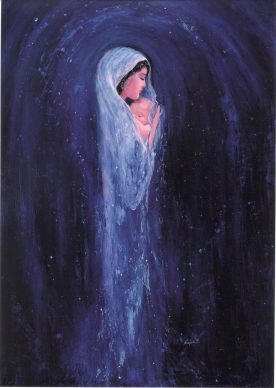Gospel Doctrine New Testament Lesson #2; Luke 1:5–25, 57–80, Luke 1:26–56; Matthew 1:18–25.
The four gospels do not harmonize on every point—each gospel offers us a different viewpoint through the distinct personalities and cultural positions of their authors. All of the gospel writers start at a beginning, though they all define the beginning differently. Mark begins with the baptism of Jesus, Matthew and Luke both begin with the mortal birth of Jesus, and John will go all the way back to the appearance of the pre-mortal Christ in the bosom of the Father. They also all portray women differently. Though women are never a majority in scripture, we can attune ourselves to look for the women: to see the presence of women, their actions, as well as noticing their absence in the text, all of which can be illuminating and instructive.
Matthew and Luke’s beginnings with the birth of Jesus reveal much about them as authors focused on their audience. Matthew is a Jew writing for Jews, and he begins with the genealogy of Jesus focusing on his ancestral lineage as a son of David and a son of Abraham which could open the way for fulfillment of the Messianic promise. Jewish genealogies are historically male-centric. Women were often considered second class citizens in the ancient world (though we need not suppose that women could not do anything), they have a prescribed place within Jewish society. Jewish culture does not harbor a cultural sensitivity that would encourage Matthew to focus particularly on women; curiously Matthew includes five women in his genealogy of Jesus.
Matthew inserts Thamar (Tamar), Rachab (Rahab), Ruth, and Bathsheba (though she doesn’t get specifically named), to join Mary in the genealogy. Why would he do that? None of these women are the highly regard Mothers of Israel (Sarah, Rebekah, or Leah). None of these women replicate the common trope of the two-dimensional woman who is either angel or devil; all these women are presented as nuanced and complicated individuals in the Hebrew Bible text. Matthew knows his audience and works to encourage his audience to accept Jesus as the Jewish Messiah. To do that, they need to accept Mary, and these women share something in common with Mary. These four women are possibly included to encourage the audience to welcome Mary.

Artist Unknown
Scenes of Tamar waiting for Judah—her father-in-law—in a place that might cause one to question her morals, Rahab—a woman of a questionable profession—“the oldest”, Ruth “laying” at the feet of Boaz (a clear euphemism), and Bathsheba labeled as a seductress show the potential to villainize women without a careful consideration of the context and a close reading of the text. A young Mary betrothed (legally contracted to be married) and pregnant, but not yet married, certainly fits well into this cross-section of women acting outside of an assumed sphere. Though each woman’s situation may have appeared questionable or scandalous on first glance, when we know the whole story we can recognize their wisdom to act in faith. Matthew expects his audience to understand that despite the potential scandal, all of these women are acting in a way that was acceptable before God. Though it is difficult to escape Matthew’s intonation that Mary is Joseph’s problem (Matt 1:18-22), he wants his audience to accept the possibility of Mary as the mother of the Messiah.
In contrast, Luke is a Gentile writing for Gentiles. Luke is concerned with the presence of women, and we see more women in his gospel than any of the others (however, we need to go to John if we want to see women really act). In Matthew, the angel appears to Joseph; in Luke, the angel appears to Mary, and Luke gives Mary a voice. With Mary and Zechariah, Luke begins a pattern of pairs that will continue throughout his gospel. Zacharias is struck dumb for his disbelief. Though initially “perplexed” (NSRV) or “greatly troubled” (NET+), this young girl, Mary, responds to the angel, “Here am I, the servant of the Lord; let it be with me according to your word.” (Luke 1:38 NSRV) Then Mary will praise God in her Magnificat. (Reading a modern translation will set the poetry apart and help us recognize it.)
And Mary said,
“My soul exalts the Lord,
and my spirit has begun to rejoice in God my Savior,
because he has looked upon the humble state of his servant.
For from now on all generations will call me blessed,
because he who is mighty has done great things for me, and holy is his name;
from generation to generation he is merciful to those who fear him.
He has demonstrated power with his arm; he has scattered those whose pride wells up from the sheer arrogance of their hearts.
He has brought down the mighty from their thrones, and has lifted up those of lowly position;
he has filled the hungry with good things, and has sent the rich away empty.
He has helped his servant Israel, remembering his mercy,
as he promised to our ancestors, to Abraham and to his descendants forever.”
(Luke 1:46-55 NET)
However, all is not lost for Zacharias, despite his doubts, he too can see the impossible occur and ultimately praises God in his Benedictus (Luke 1:67-79). Whether we are like Mary or Zacharias, we might all be blessed. As Luke juxtaposes male and female examples he chooses to highlight that the gospel is for all. The baby Jesus was born of a woman. Women are essential to help us understand the earthly beginning of Jesus who would become the Savior of humankind. Reading scripture closely opens up the broad world of God’s compassion to us. As we pay attention to women in the gospel narratives we can better understand how God will interact with humanity, we can better recognize the hand of God in our lives, and more wholly believe that “nothing be impossible with God.” (Luke 1:37 NSRV)
